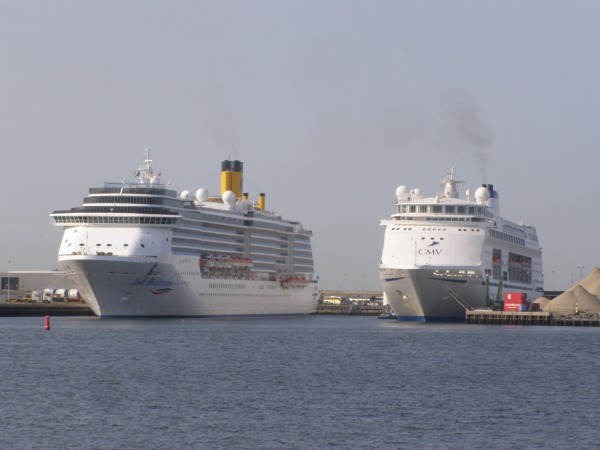Columbus
Background
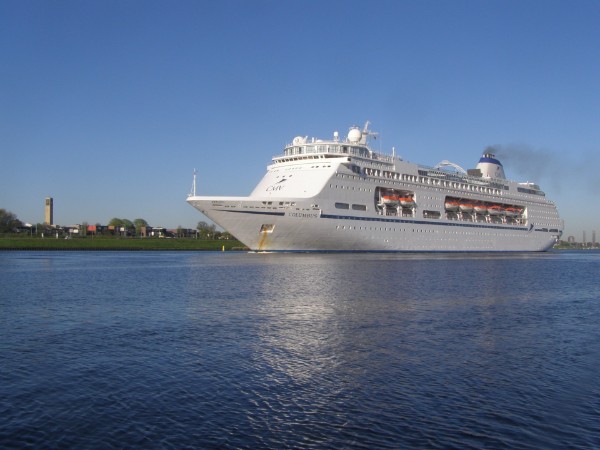
A regular visitor to The Netherlands now, Columbus is seen here sailing past IJmuiden at the 7th of may in 2018.
When Sitmar Cruises launched their first newbuilding cruiseliner in 1984, the Fairsky, they immidiately understood that this was the new way they had to go if they wanted to share a piece of the growing cruisemarket. The Fairsky was their biggest cruiseship to date (46.314 tons), but the thought was they had to go even bigger. So at the 25th of june 1986 the contract was signed with Chantiers de L'atlantique at Saint Nazaire in France to built them a 63.000 ton cruiseliner for delivery in 1988. There was also signed an option of a sistership, but this plan was never realized. Her name was to be picked from suggestions that were made by the employees of the company and that name became FairMajesty. With the ships introduction, also a new colourscheme and a new funnellogo were to be introduced for Sitmar. Besides that, the ships of the line would be renamed with the prefix of the company name, so FairMajesty would be sailing her first cruise as Sitmar FairMajesty. This new scheme was introduced in 1987 to the Fairwind, build in 1956 as Cunard's Sylvania. She was renamed Sitmar Fairwind, but she would be the only ship sailing in these new colours and under the new name because Boris Vlasov, owner of the company and creator of Sitmar FairMajesty, died at the 2nd of november 1987. As a financial safeguard for his family, Boris had set up a trust so when he died, the company would be sold and the sum would go to his family. Of course, with the fleet and the big newbuilds on the horizon, other companies were eager to take over and P&O did, at the 28th of july 1988 for $210 million.. At that time, Sitmar FairMajesty and two other newbuilds, the later Crown Princess and Regal Princess, were rated among the biggest ships in the world and P&O was to double their Princess Cruises fleet in just one year!
Below is Columbus seen as P&O's thirth Arcadia, as seen at the cruiseterminal in Amsterdam at the 24th of july 2002.
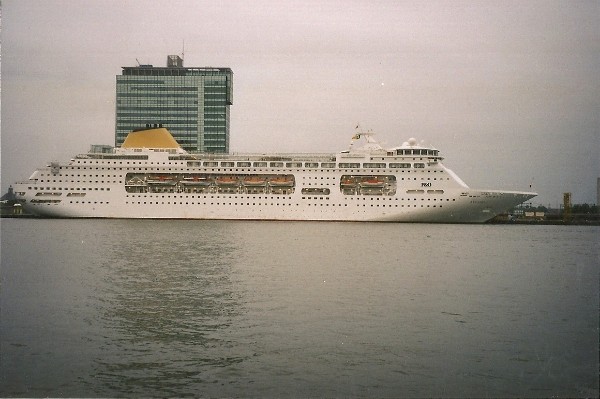
Construction and general statistics
She was built at the famous Chantiers de l'Atlantique wharf at Saint-Nazaire, France under yardnumber B29. Sitmar FairMajesty measured some 63,524 tons and she was 245,60 meters long, 32,20 meters wide and her draft reached 7,70 meters. Accomodations are there for 1621 passengers originally, as well as 634 crewmembers. She is powered by four 8-cylinder diesel engines of MAN B&W design, driving two screws and providing her with a speed of 21 knots maximum or 19,5 normally. The floatout of the Sitmar FairMajesty happened excactly two months before the sale, at the 28th of may. So when she floated out, the new colours and the name were already in place.
Design
The ship, like her later fleetmates Crown Princess and Regal Princess, was designed as an Italian ship, very different from the other ships in the Princess fleet. In the early stages of designing the ship (and her later sisters) was considered to give them steam propulsion, like the Fairsky. But because it was already hard to find suppliers, spare parts and repairers for steam turbines, it was decided to built them with a diesel-electric system. Fairsky thus became the last cruiseship to be built with steamturbines. The final push was the succesfull conversion of the Queen Elizabeth 2 in 1986 at Lloyd Werft in Bremerhaven from steamturbine to diesel-electric propulsion. Sitmar FairMajesty was actually fitted with the same model of engines used in the Cunard-ship. A distinctive feature in the exteriour of the ship was a three deck high lifeboat recess in her sides. Nowadays, its very common, but Sitmar FairMajesty was the first ship to be built like this.
Carreer
In january 1989 she was renamed Star Princess (I) and her Sitmar-logo was replaced by the princess with her hair in the wind. She was named by Audrey Hepburn on the 4th of march that year. Princess Cruises was very delighted with this new ship, that even a souvenir commemorative book was dedicated to her, a thing that was, and still is not, very common with new Princess Cruises ships. She became a very popular member of the Princess fleet, that, with Crown Princess and Regal Princess following the next years, started to grow rapidly. The Sun-class followed in the mid 1990's, slightly bigger ships and actually the first one, Sun Princess, was the biggest cruiseship in the world by then.
Again Arcadia in Amsterdam at the same day, just seen from a different angle.
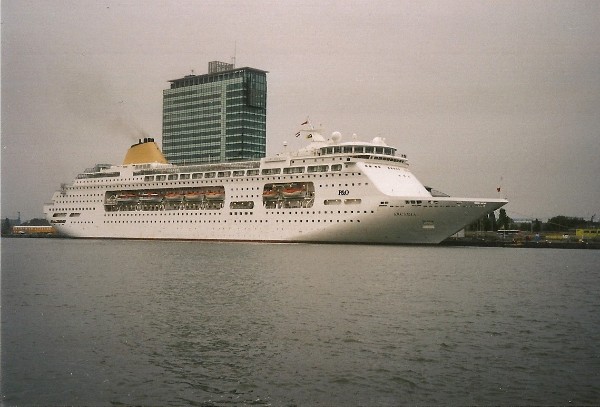
In 1994, P&O launched a great new ship within their own fleet, the first P&O ship that was designed as a cruiseliner for the old company. In the years before, all newly built ships were added to their Princess Cruises brand and only the old mailsteamer Canberra was sailing under the P&O Cruises name. The name of the new ship was Oriana (II), a very popular name still from the old Orient Lines that merged with P&O in 1964. Also, they added the Victoria to their P&O Cruises fleet, a ship that formerly had been the Sea Princess. It became clear that, besides Princess Cruises, P&O itself was starting to grow. In 1997, the old Canberra was send off and she was scrapped in India. Although the ship was really over the end of her active life, she was a very popular classic liner. Especially for the Brits, who recognized in her a ship that was the link between the parts of the Bitish Empire. Together with Queen Elizabeth 2, Canberra was the pride of the nation. But P&O did plan a replacement, and the choice fell on the Star Princess. Of course, it was by no means possible to give her the name of Canberra, so she was renamed Arcadia after her accomodation was updated in december 1997. At the same time, her public lounges were decorated with memorabilia from her grand predecessor. It was the thirth time that the name Arcadia was used in P&O's history. The first Arcadia was one of a class of four, besides Arcadia these were Victoria, Britannia and Oceana. They were all built in 1887, and were given patriotic names because of the Jubilee of the company, as well as the Jubilee of Queen Victoria. Because of these events, they were of course the biggest ships of P&O measuring the staggering 6.500 tons! The second Arcadia was built in 1953 for the mailrun between Southampton and Australia. She was rather shortlived, because the decline in passenger traffic she was eventually scrapped in 1979 at Kaohsiung on Taiwan, after just 26 years of service.
For a slight moment, I was afraid that the STI Battersea would 'batter' my ideal photomoment with my old friend, but luckily they seem to pair up very nicely.
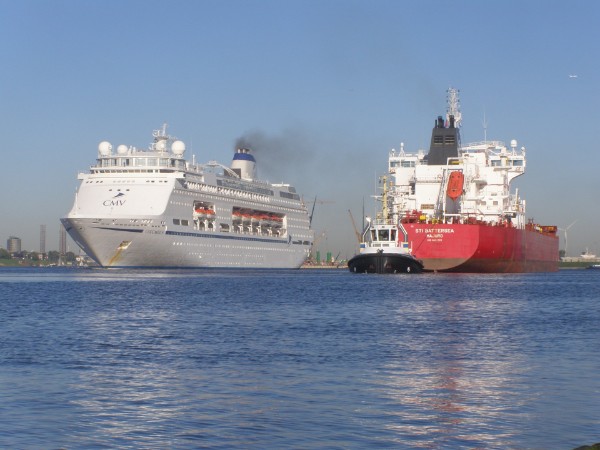
For P&O the new Arcadia regularly sailed summer cruises out of Southampton, although she was actually sailing worldwide cruises. She did manage to attract former Canberra passengers, although Oriana more or less is considered to be the real replacement for this widely loved liner. In 2003, Arcadia left the fleet of P&O to open a new P&O company named Ocean Village as a Mediterranean clubship. She was rebuilt for her new role inside, although the distinctive change from the outside was the Ocean Village logo hullart that was added to the sides of the ship. Her new name was also that of the new company, and she thus was named Ocean Village on the 28th of april 2003 by Ulrika Johnson, a Swedish popular TV presenter. For Ocean Village, she then started sailing youth-orientated cruises in the Mediterranean during summer and the Caribbean during winter. This company was to be marketed as a company that sailed cruises, strangely, for 'people who don't do cruises'. The ship was rebuilt in a resort-style, including self-service meals and a lot of active and sporting possibilities. Because of this, she was really a new type of cruiseship. Within Ocean Village, she was joined by Ocean Village Two in 2007, so the concept seemed to be popular. Her new fleetmate was the former Crown Princess and AIDAblu, so two former Sitmar-designed ships were together again. Although this success, rather surprisingly it was announced that Ocean Village would be discontinued after the 2010 Mediterranean season. Ocean Village Two transferred down-under in 2009 under her new name of Pacific Jewel, and Ocean Village herself joined P&O Australia at the end of 2010 as Pacific Pearl. They met another old Sitmar-sister there, the former Regal Princess that now sailes as Pacific Dawn.
The 2016-season was the last season for Pacific Pearl sailing for the P&O Australia brand, as she was sold and began her sailings for British-based CMV Cruises from the 2017 season onwards. For this company, Pacific Pearl was re-named Columbus, truly showing the namingstyle of CMV. Next to Columbus, the company also sails with Marco Polo (1964) and Magellan (1984) so they clearly take their inspiration from the names of well-known explorers. Except for those, as the company also owns the Transocean Tours brand, the Astor (1980) and Astoria (1946) are also part of the fleet. For CMV, Columbus started sailing out of the port of Tilbury, dedicated to the British market. This of course is not new for the ship, because of her history with P&O Cruises.
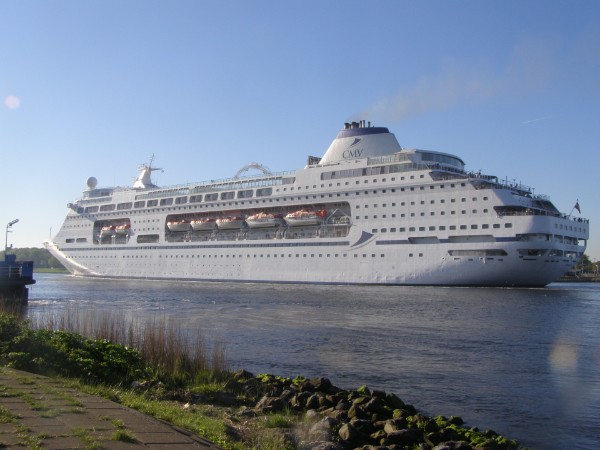
The ship was delivered to CMV at Singapore at the 12th of april 2017, before heading to the Damen Shipyards at Rotterdam for a complete overhaul and repaint. Here, she arrived at the 13th of may. CMV and Damen have a very strong connection as the British line always had its ships overhauled at the yards of this company in either Amsterdam or Rotterdam. At the 5th of june, Columbus arrived at Tilbury in England, where was named by Angela Rippon at june the 8th. On june 11th, the newest addition to CMV's fleet departed for a short three-night cruise to Amsterdam and Antwerp, followed by a six-night cruise to the Norwegian fjords. After a series of European cruises, the ship crossed the Atlantic for a season of cruises in the Caribbean, around Cuba and central America. In 2018, she sailed the first round-the-world cruise for CMV.
A small mishap befell the ship after leaving Amsterdam at the 30th of may in 2019. While leaving, her hull scraped the bottom of the IJ but the ships captain didn't think it was a serious problem. So Columbus left the IJmuiden locks for her cruise to Norway as planned. Somewhere at the North Sea however, the ships rudder wasn't reacting as it should be and the captain then decided that it would be too big of a risk to bring the ship into the small Norwegian fjords. Columbus returned to IJmuiden where she was moored in the outer harbour for inspections. Afterwards, she was leaving for the Damen repairyards at Amsterdam, later Rotterdam. Repairs were quite extensive and two cruises had to be cancelled in the process.
During her repairs, Columbus met Costa Mediterranea in IJmuiden at the 4th of june 2019. She was able to leave later that day for the Damen repairyards at Amsterdam, before again swiching to Rotterdam.
